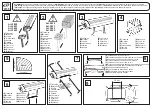
Fig. 2
Fig. 3
Screw in the EPA screw (Fig. 2) to reduce the idle travel range.
The EPA screw must then be adjusted (Fig. 2). The further it is backed out, the closer the
brake lever is to the stop (Fig. 3). The further it is screwed in, the further away the brake
lever is from the stop marked in Fig. 3. The EPA screw must be adjusted so that the brake
lever can only be pushed away from the handlebar with resistance (opposite to the direc-
tion in which the brake lever is operated). Then, by adjusting the EPA screw, reduce the idle
travel range, that is, the travel distance between the starting position of the non-activated
brake lever and the bite point position of the activated brake lever. Under no circumstan-
ces may the EPA screw be screwed in so far that the CPA screw begins to activate the en-
coder piston in the initial position of the brake lever. If the EPA screw is screwed in beyond
this activation point, the hole to the reservoir may be continuously closed and the brake
may suddenly lock, causing the rider to suffer a bad fall.
IMPORTANT: A locking of the brake can only be prevented if there is sufficient idle travel
range and / or the brake lever is not continuously activated.
Functional test after each change of setting
After each change of the idle travel range by means of the EPA screw and / or each change
of the bite point setting by means of the CPA screw, the brake system must be checked and
tested for proper function.
CAUTION: Danger due to sudden blocking of the brake | It is essential to follow these instructions!
If the brake lever is continuously activated, the brake lever‘s idle travel is reduced too
much or the brake is insufficiently vented, the brake may suddenly lock due to heat-indu
-
ced expansion of the mineral oil, air in the brake system or other reasons. For this reason,
there must always be a free travel range for the brake lever and it must not be continuous-
ly activated. To reduce the free travel range properly and to the permitted extent, please
follow the above instructions for setting the Root-Lever Pro. Otherwise, volume compen-
sation to the brake reservoir can no longer be guaranteed. Especially if there is air in the
brake system or if it is heated excessively, the brake may lock and the rider may suffer a
severe fall.
OAK encourages all Root-Lever Pro users to scrupulously follow these instructions.
27


































